на фото комнатные оформления вертикальных групп
Содержание
- Оформление горшечных цветов
- Композиции из горшечных растений и цветов и их фото
- Горшечная группа в лотке с галькой
- Вертикальные композиции из цветов в горшках
- Цветочные композиции комнатных растений в горшках и их фото
Цветы в горшках и их композиции — это возможность с помощью самых обычных растений создать атмосферу уюте и тепла в любом помещении. Горшечные композиции позволяют решать множество задач, стоящих перед дизайнером, оформляющим то или иное помещение. Достаточно посмотреть на фото горшечных композиций цветов на этой странице, чтобы стало понятно, что подобное решение позволяет эффективно скрывать существующие недостатки и подчеркивать достоинства.
Нельзя отрицать, что выдающееся растение заслуживает места в отдельном сосуде, способном создать ему должное обрамление. Но обычные комнатные растения не такие уж выдающиеся, и для них композиции из цветов в горшках предоставляет ряд преимуществ.
Существуют всевозможные способы объединить несколько горшков в группу. Композиция может быть горизонтальной или вертикальной. Горшки могут просто стоять рядом, а могут быть собраны вместе в каком- либо открытом приспособлении, например, металлической жардиньерке или большом поддоне. В викторианскую эпоху для группировки горшков использовали многоярусные металлические подставки, в том числе популярные угловые этажерки. Эти этажерки перешли в разряд антиквариата.
Растения могут быть скромными или являть буйство цвета — тут нет никаких жестких правил. Способы группировки и виды горшков могут быть как очень простыми, так и поистине изощренными. Основная цель создания горшечной группы — сделать часть комнаты более интересной за счет живого цвета.
Оформление горшечных цветов
Используя определенное оформление горшечных цветов, можно правильно расставить акценты и привнести нотку новизны в уже сложившийся дизайн помещения. Ключевая особенность горшечной группы в том, что растения и горшки образуют единое целое, в котором каждое растение обычно оказывает влияние на своих соседей.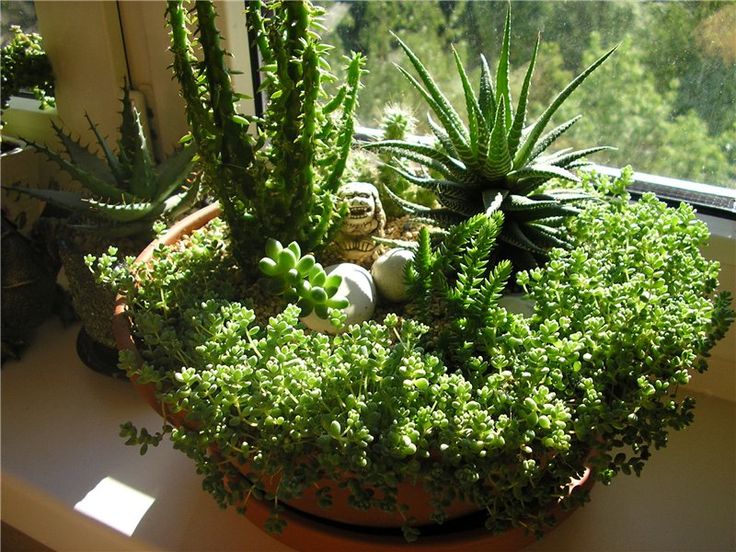 Это может быть снижение освещенности, увеличение влажности воздуха или ограничение роста.
Это может быть снижение освещенности, увеличение влажности воздуха или ограничение роста.
Преимущества группировки: в группе могут быть скрыты несовершенства. Растения, расставленные по комнате, имеют тенденцию повреждаться с течением времени. Нижние листья некоторых видов, таких как кротон, могут опасть из-за сухости воздуха. Обгоревшие на слишком ярком солнце кончики листьев пальмы и диффенбахии должны быть удалены. Кроме того, непривлекательный вид растению часто придают небольшие соцветия на длинных стебельках. Может возникать и ощущение дисбаланса от однобокого растения. Эти и другие дефекты неизбежны — выход в том, чтобы собрать растения в горшечные группы, в которых основания стеблей, обрезанные листья и длинные цветоносы скрыты.
В группе за растениями легче ухаживать. Ритуал ухода за множеством растений, расставленных по комнате, включает в себя перемещение от горшка к горшку. Когда растения собраны в горшечную группу, использовать лейку или опрыскиватель намного удобнее. Это не такая уж большая экономия времени и усилий, но есть и другие источники экономии времени. Слабые стебли, однобокий прирост и гибкие соцветия у растений в отдельных горшках требуют подвязки, но в группе эти своенравные стебли часто могут быть поддержаны их более высокими соседями. Кроме того, задача систематической срезки побуревших кончиков листьев и других дефектов в группе не так актуальна, поскольку имеется много других листьев, способных замаскировать эти недостатки.
Это не такая уж большая экономия времени и усилий, но есть и другие источники экономии времени. Слабые стебли, однобокий прирост и гибкие соцветия у растений в отдельных горшках требуют подвязки, но в группе эти своенравные стебли часто могут быть поддержаны их более высокими соседями. Кроме того, задача систематической срезки побуревших кончиков листьев и других дефектов в группе не так актуальна, поскольку имеется много других листьев, способных замаскировать эти недостатки.
В группе растения лучше развиваются. Установлено, что многие растения выигрывают от нахождения в группе рядом с другими, по сравнению с выращиванием в изоляции. Обычно это объясняют тем, что в группе формируется особый микроклимат. От испарения влаги с недавно опрысканных листьев и политой поверхности компоста в окружающих горшках воздух становится более влажным. Это увеличение влажности способствует уменьшению подсыхания и сморщивания листьев влаголюбивых растений, таких как ажурные папоротники.
В группе растения, как правило, выглядят лучше.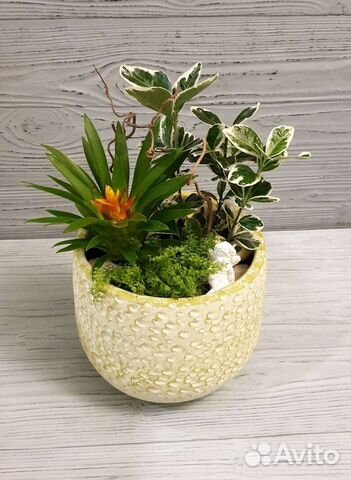 Горшок с привлекательным растением может стоять отдельно, а может быть сгруппирован с другими. В группе такое растение будет создавать интересный фокусный центр. Большинство же мелколистных и низкорослых растений не имеют высокой степени визуальной привлекательности, и когда их выращивают как отдельные растения, часто кажутся невзрачными. Зато в горшечной группе они способны взять на себя три функции, которые значительно увеличивают декоративность всей группы в целом. Они могут заполнить зеленью промежутки между горшками и пространство перед видными экземплярами растений. Кроме того, цветение скромного растения в состоянии существенно украсить композицию само по себе. Ампельные растения смягчают вид переднего края контейнеров в горшечной группе.
Горшок с привлекательным растением может стоять отдельно, а может быть сгруппирован с другими. В группе такое растение будет создавать интересный фокусный центр. Большинство же мелколистных и низкорослых растений не имеют высокой степени визуальной привлекательности, и когда их выращивают как отдельные растения, часто кажутся невзрачными. Зато в горшечной группе они способны взять на себя три функции, которые значительно увеличивают декоративность всей группы в целом. Они могут заполнить зеленью промежутки между горшками и пространство перед видными экземплярами растений. Кроме того, цветение скромного растения в состоянии существенно украсить композицию само по себе. Ампельные растения смягчают вид переднего края контейнеров в горшечной группе.
Композиции из горшечных растений и цветов и их фото
Композиции из горшечных растений могут составляться в различных вариантах и сочетаниях. Стандартная композиция из горшечных цветов может быть применена в любом помещении, а вот для художественной группировки может потребоваться опыт и знания.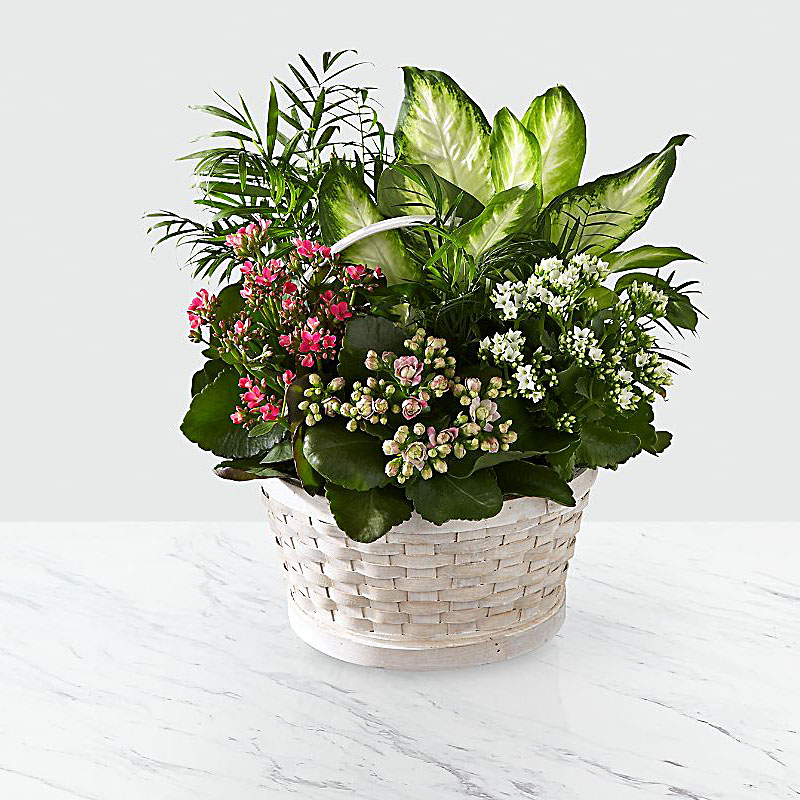
Далее можно посмотреть композиции из горшечных растений на фото, которые иллюстрируют способы их расстановки:
Стандартная группировка. Стандартная горшечная группа — это собрание растений в отдельных горшках, размещенных близко друг к другу. В ней основным интересным объектом являются растения, а не контейнеры. Чтобы создать горшечную группу, которая имеет такой вид, как будто сделана профессиональным декоратором, используйте общепринятые принципы дизайна. В разделе про основы хорошего дизайна вы получили некоторое представление о принципах создания композиций, а в разделе про определение места для растений о лучшем положении для них. И теперь пришло время подумать о выборе горшков для группы — в этом поможет раздел про подходящие емкости. Слишком большое разнообразие окрасок, размеров и форм испортит стандартную горшечную группу.
Пора приобрести растения. Выберите три или другое нечетное количество растений.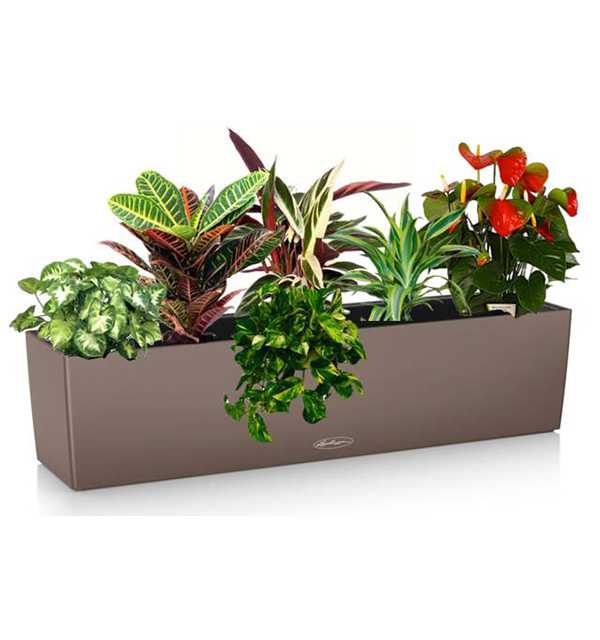 У всех растений в группе должны быть похожие потребности в температуре и освещенности. Также должен присутствовать ряд разнообразных высот и текстур. Обычно выбирают декоративнолистные растения для постоянной основы и несколько цветущих растений для придания композиции цвета.
У всех растений в группе должны быть похожие потребности в температуре и освещенности. Также должен присутствовать ряд разнообразных высот и текстур. Обычно выбирают декоративнолистные растения для постоянной основы и несколько цветущих растений для придания композиции цвета.
Составление композиции. Если горшечная группа будет просматриваться только спереди и по бокам, то в соответствии с общим правилом высокие растения должны быть сзади, а менее крупные на переднем плане. Прямых линий следует избегать — например, снизить высоту задней части по сторонам и обеспечить перепады высот, чтобы создать ощущение движения. Общая форма композиции является делом личного вкуса; популярностью пользуется неправильная пирамида. Если композицию предполагается рассматривать со всех сторон, более высокие растения размещают в середине, окружая их растениями меньшего размера. И снова необходимо нарушить эту общую форму, чтобы обеспечить динамику.
Небольшое предупреждение.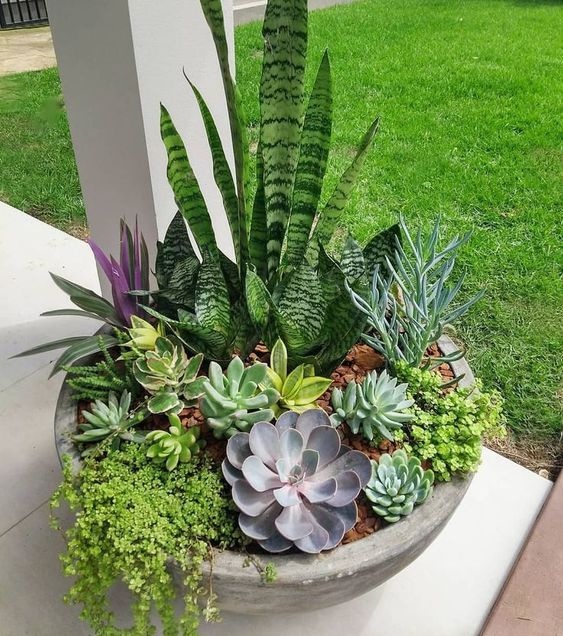 Вряд ли буйство различных цветов, форм и текстур обеспечит вашей горшечной группе профессиональный вид. Композиции, созданные дизайнерами по интерьерам, часто довольно сдержанны и могут состоять из одних только декоративнолистных растений.
Вряд ли буйство различных цветов, форм и текстур обеспечит вашей горшечной группе профессиональный вид. Композиции, созданные дизайнерами по интерьерам, часто довольно сдержанны и могут состоять из одних только декоративнолистных растений.
Художественная группировка. Дизайнеры иногда создают большие и экзотичные горшечные группы, наполненные великолепными растениями в необычных контейнерах. Но размер, тип и цвет растений не являются основными особенностями художественной горшечной группы. Есть только два основных требования.
Во-первых, используются горшки, как минимум двух различных высот — это создает ощущение объема. Во-вторых, подбор горшков не менее важен, чем подбор растений — в композиции оба эти компонента должны быть декоративными.
Кашпо являются одними из основных элементов. В композиции, показанной выше, заднее кашпо содержит пальму, которая намного выше остальных растений. Растения меньшего размера можно устанавливать, приподняв их с помощью деревянного бруска под горшком.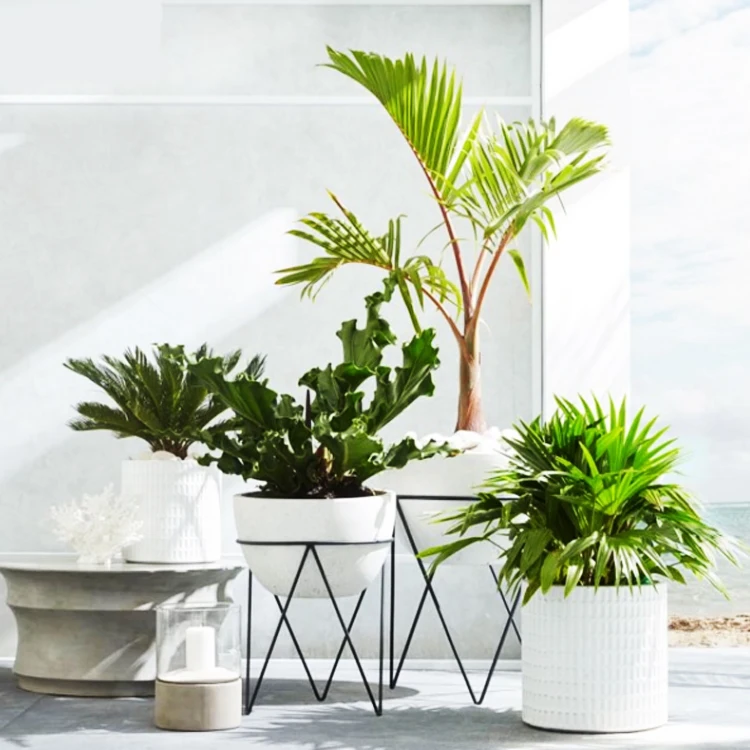 Очень важно, чтобы это верхнее растение обеспечивало максимальную декоративность. Самый маленький горшок содержит цветущее горшечное растение, которое заменяют, когда цветы увянут. Ампельное растение выращивается в одном из средних сосудов, и его стебли свободно спадают по основанию композиции.
Очень важно, чтобы это верхнее растение обеспечивало максимальную декоративность. Самый маленький горшок содержит цветущее горшечное растение, которое заменяют, когда цветы увянут. Ампельное растение выращивается в одном из средних сосудов, и его стебли свободно спадают по основанию композиции.
Горшечная группа в лотке с галькой
Горшечная группа в мелком лотке с галькой— отличный способ выращивания тех растений, которые нуждаются в высокой влажности в централизованно отапливаемом помещении. Если у вас плохо растут узамбарские фиалки или орхидеи, попробуйте поставить их на лоток с галькой. Высота лотка должна быть около 5 см. Если лоток будет стоять на подоконнике, сделайте так, чтобы он не слишком выступал за его пределы.
Поместите на дно лотка 3 см гальки. Группируйте растения на поверхности этого слоя.
Хорошее место для лотка с галькой на полке радиатора под подоконником. В этих условиях влажность вокруг растений в зимний период будет в три раза выше. Полив является простым делом — вода может свободно вытекать из горшков в лоток. Уровень воды не должен подниматься выше поверхности гальки.
Уровень воды не должен подниматься выше поверхности гальки.
Вертикальные композиции из цветов в горшках
Цветы в горшках композиции позволяют создавать в различных плоскостных направлениях. Вертикальные композиции из цветов являются наиболее излюбленным приемом дизайнеров интерьеров.
Вертикальная композиция позволяет зрительно увеличить высоту потолка в помещении и озеленить самые неприметные уголки. Горшечные группы почти всегда располагают горизонтально. Однако можно легко устроить вертикальную композицию, способную выглядеть чрезвычайно эффектно. Традиционная версия представлена угловым стеллажом с горшком на каждой полке.
В таких случаях используют одну разновидность красочных ампельных растений, образующих колонну из листвы или цветов. Для создания того же эффекта может быть использован ряд подвесных корзин, прикрепленных друг к другу. Металлическая или деревянная подставка с горшками на разных высотах удобна тем, что она портативна.
Цветочные композиции комнатных растений в горшках и их фото
Цветочные композиции в горшках могут сочетать в себя как один, так и несколько оттенков цветения. Многие цветочные композиции комнатных растений составляются таким образом, чтобы добиться практически непрерывного цветения на протяжении всего года. Многокомпонентные комнатные цветочные композиции требуют специального ухода, в частности досвечивания в зимний период и специальных подкормок.
Многие цветочные композиции комнатных растений составляются таким образом, чтобы добиться практически непрерывного цветения на протяжении всего года. Многокомпонентные комнатные цветочные композиции требуют специального ухода, в частности досвечивания в зимний период и специальных подкормок.
Далее показаны композиции в горшках на фото, которые показывают разнообразие возможных вариантов:
Многоцветная группа. Многоцветные горшечные группы так же популярны, как и цветочные композиции этого типа — собрание ярких цветов среди разнообразной листвы. Некоторые дизайнеры не без оснований считают, что это слишком броский способ использовать комнатные растения. Это верно, если многоцветная группа ошибочно используется в комнате с ярким сложным рисунком на ковре, обоях, картинах и т.д. В простой комнате, однако, многоцветная группа может значительно оживить обстановку.
Приглушенная группа. Доминирующим элементом является листва растений.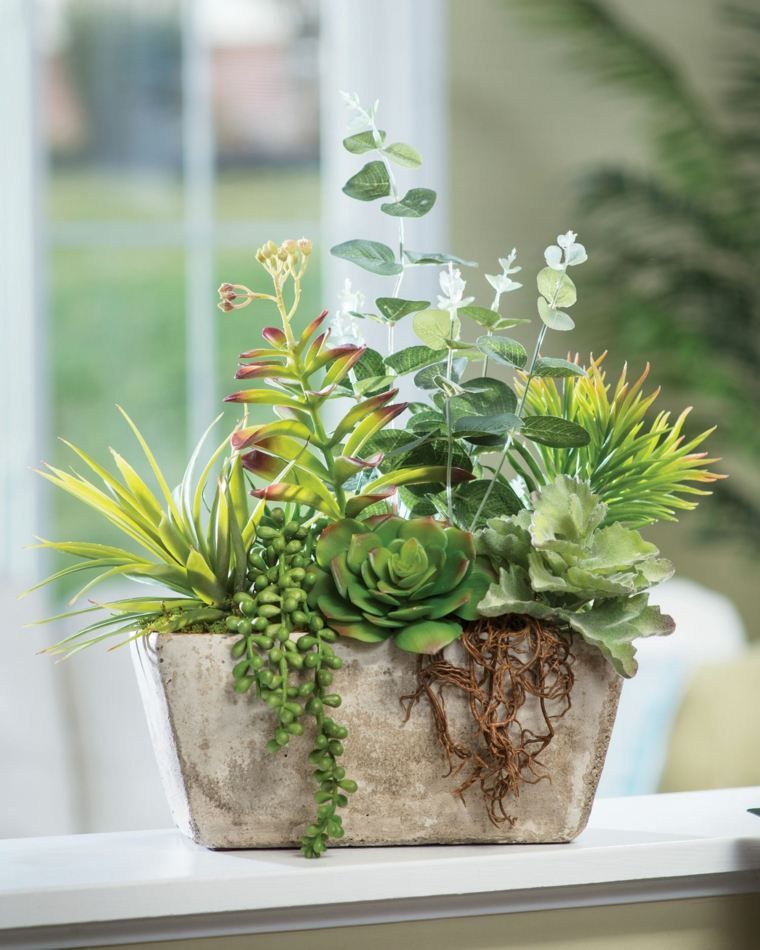 Чтобы обеспечить преобладание зеленого цвета, используют растения с перистыми и цельными листьями. Для украшения композиции можно включить несколько горшечных растений с пастельными цветками, но яркость и контраст всегда должны быть умеренными. Приглушенная композиция хорошо смотрится перед узорными обоями или шторами; она также оказывает успокаивающее действие при размещении вблизи ярких цветных или витиеватых предметов мебели.
Чтобы обеспечить преобладание зеленого цвета, используют растения с перистыми и цельными листьями. Для украшения композиции можно включить несколько горшечных растений с пастельными цветками, но яркость и контраст всегда должны быть умеренными. Приглушенная композиция хорошо смотрится перед узорными обоями или шторами; она также оказывает успокаивающее действие при размещении вблизи ярких цветных или витиеватых предметов мебели.
Одноцветная группа. Синие или белые бордюры и покровные цветники из одного вида однолетников пользуются популярностью в некоторых европейских странах. Несмотря на то, что это принято в открытом грунте, одноцветные группы редко можно встретить внутри помещений, если, конечно, это не набор декоративнолистных растений. Одной из самых популярных композиций из комнатных растений является одноцветный комнатный садик — чаша, заполненная желтыми нарциссами или розовыми гиацинтами.
How to create an arrangement of indoor flowers and houseplants – Flowers at home
Grow beautiful indoor plants – this one, but to do so, so that they «play» in the interior, made it unique – completely different. And for this it is important to know the main features.
And for this it is important to know the main features.
DIY flower arrangements
ATTITUDE TO THE LIGHT
The plant organism is highly plastic. Every florist knows, how much the appearance of a plant can change when it is moved from a bright place to a dark one and vice versa. But, no matter how great the plasticity, adaptability of plants, the best results are obtained by the maximum approximation of artificial conditions to natural. That’s why, first of all, it is important to study the microclimate of the room and only then pick flowers.
Light – major environmental factor, which is decisive for plants, because thanks to him, a unique phenomenon occurs in green cells – converting the energy of the sun into organic matter with the absorption of carbon dioxide and the release of oxygen. Under the influence of a light source, plants are able to turn in its direction. This reaction is called phototropism and it is very important to remember about it when placing plants.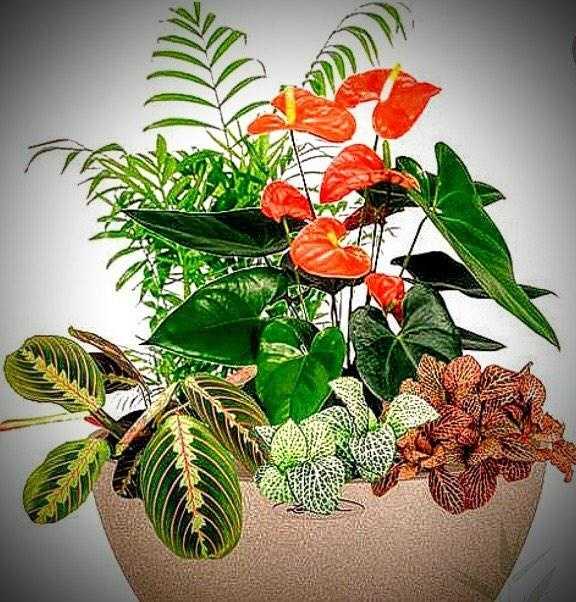 . It has long been known, that light is limiting (limiting) factor for the development of plants in the interior. The growth rate depends on the light regime and is associated with the ecological nature of plants (saintly, shade-loving). So, eg, shade-loving plants actively grow and develop under illumination of about 700-1000 luxury, and light-loving – at 1500-5000 luxury. The dormant period for shade-loving people begins when the intensity of illumination decreases to 140 luxury, and for light-loving ones, up to 700 luxury.
. It has long been known, that light is limiting (limiting) factor for the development of plants in the interior. The growth rate depends on the light regime and is associated with the ecological nature of plants (saintly, shade-loving). So, eg, shade-loving plants actively grow and develop under illumination of about 700-1000 luxury, and light-loving – at 1500-5000 luxury. The dormant period for shade-loving people begins when the intensity of illumination decreases to 140 luxury, and for light-loving ones, up to 700 luxury.
When composing a composition, it is worth considering, that with side illumination, more light enters its edges, than in the middle. Therefore, you can safely combine plants, who love to bathe in the sun, with topics, that they do not take such plentiful sunbathing. You just need to plant them in the right place.. In the rooms, receiving one-way lighting from windows, plants can grow lopsided and twisted.
To prevent this from happening, they need to be gradually turned towards the light in different directions, but always in one direction.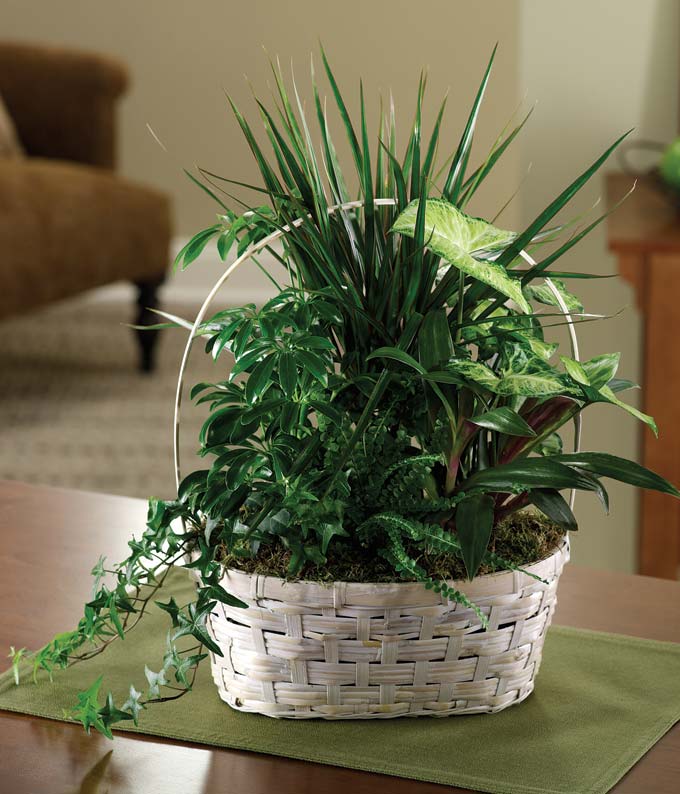 This simple technique ensures even growth., as a result of which lush bushes with symmetrically located shoots are formed. Usually houseplants are placed on or near windows. So you need to know, how much sunlight they give to plants in natural side light:
This simple technique ensures even growth., as a result of which lush bushes with symmetrically located shoots are formed. Usually houseplants are placed on or near windows. So you need to know, how much sunlight they give to plants in natural side light:
- south windows: open to the sun for 6-9 h and let in the maximum amount of light. Usually succulents are placed here., palm trees, eternal, hippeastrum, jasmine, coleus et al. But many of them cannot stand direct sunlight and need shading at midday.;
- east and west windows: sunlight enters the room in the first or second half of the day, respectively 3-4 h. Asparagus can be grown here, aukubu, begonias, uzambara violet, streptocarpus and other plants.
By the way. In the hours of the most intense light, these plants require shading., otherwise, burns may appear on the leaves, as a result of which they dry out. If such rooms have large windows, letting in a lot of light, most light-loving plants can be successfully grown here.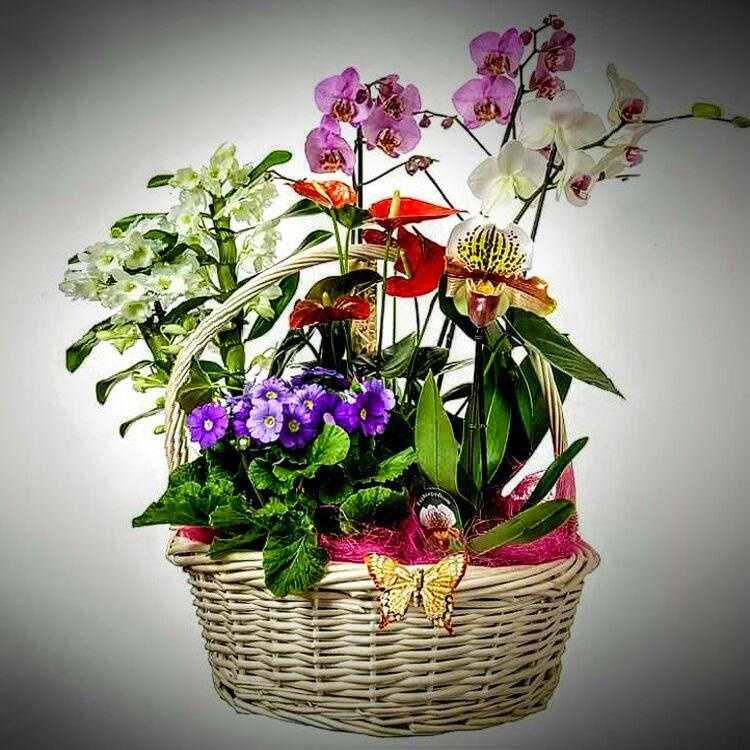 ;
;
- north windows: let in the least amount of light. They are suitable for growing shade-loving plants, for which low light is considered the norm (ferns, aspidistra, tradescantia, etc.). Light-loving plants can be grown here only with additional artificial lighting..
Indoor plants are placed in relation to the window, through which natural light enters, So: saintly – in the zone 1-3 m (illumination from above 5000 deluxe for hours), shade-loving – in the zone 3-6 m (illumination from above 1000 deluxe for hours). Plants can only be placed outside these areas with artificial lighting. (minimum intensity 100-300 W / sq. m during 10-12 h). Additional artificial lighting can be not only a necessary condition for keeping a houseplant in the autumn-winter period, but also a decorative technique, highlighting the natural beauty of the plant and creating a certain atmosphere.
DIY flower arrangement
It is important to consider, that the different position of the light source in relation to the plant leads to different visual effects;
- – light from a lamp or multiple lamps, located above the plant or group composition, called directional.
 It serves to, so that, one side, create an impression of the integrity of the composition, on the other hand, highlight its individual elements;
It serves to, so that, one side, create an impression of the integrity of the composition, on the other hand, highlight its individual elements; - – light from a lamp or multiple lamps, installed at floor level below the plant, called highlighting. This placement of the light source will accentuate individual details and create a shadow on the wall behind the plant.;
- – light from lamp, located at floor level behind the plant, called back. It focuses on the silhouette of the plant and creates a mystical and mysterious atmosphere.. Typically used to illuminate large specimen (single) plants.
For decorative illumination of indoor plants, it is better to use lamps with a point light source., or spotlights. The optimal distance from the lamp to the plant can be determined empirically.. To do this, you just need to install the lamp at some distance from the plant and turn on, and then just bring your palm to the sheet nearest to the light source. If you feel warm, means, the lamp is too close to the plant. For your information. Decorate the composition, to create a play of shadows and highlight individual instances, directional lamps will help.
For your information. Decorate the composition, to create a play of shadows and highlight individual instances, directional lamps will help.
Очень красивая композиция из комнатных цветов на РАЗ-ДВА-ТРИ! СМОТРИ и ДЕЛАЙ!
Watch this video on YouTube
TEMPERATURE AND HUMIDITY
For the successful maintenance and reproduction of indoor plants, it is very important to observe the ratio of temperature and humidity..
Humidity. Very strongly affects the course of the process of photosynthesis, and consequently, and on the formation of a nutrient in plant leaves – glucose, and then starch from it, extremely important for the life of plants. The optimal value, necessary for the normal life of plants, is 50-80% relative humidity. But there is a whole group of plants, in which, for normal life, this indicator can calmly fluctuate within 25-30%. Such plants include cacti and other succulents., which can be called drought-resistant plants.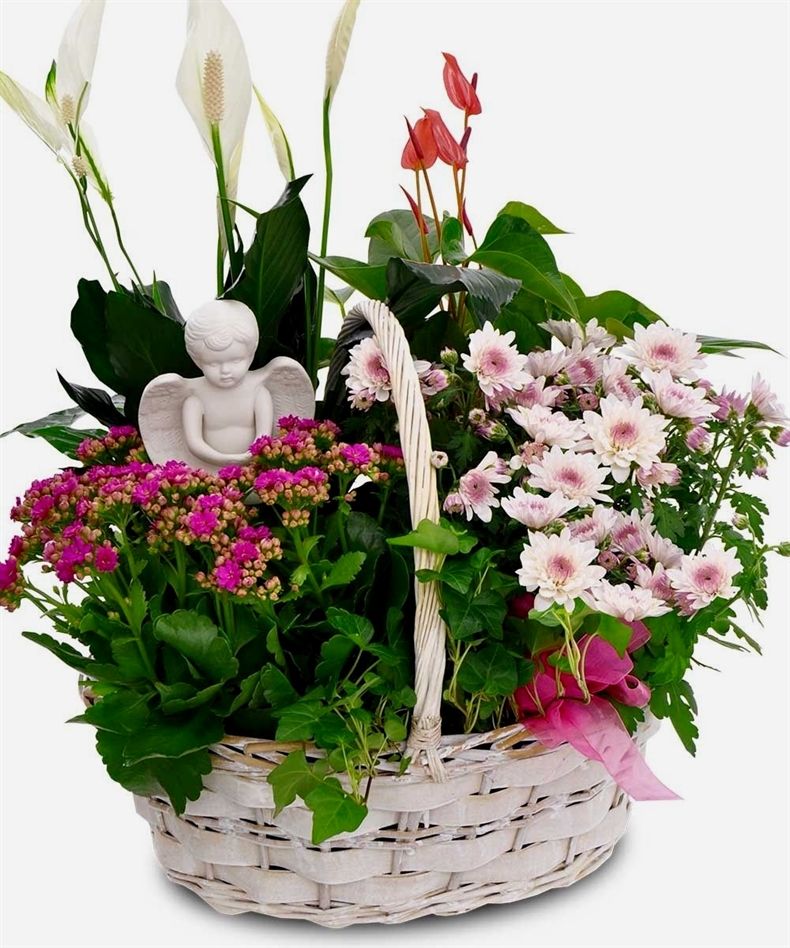 In this case, it is necessary to take into account, that with the beginning of the heating season, the dryness of the air increases. To make plants feel good during this period of the year, near them you can place cups or saucers with water.
In this case, it is necessary to take into account, that with the beginning of the heating season, the dryness of the air increases. To make plants feel good during this period of the year, near them you can place cups or saucers with water.
Relative humidity – this is the ratio of the amount of moisture, in the air, to that amount, which it can contain at the same temperature. Calculated relative humidity as a percentage. for example, relative humidity is 70%. This means, what the air contains 70% that amount of steam, which it can accommodate at a given temperature.
DIY flower arrangements
Temperature. Each grower must comply with the temperature regime, optimal for his green pets (or close to it), and remember when placing plants, that at different points in the room the thermometer readings may vary: at the balcony door they are lower by 3-4 FROM, at the central heating radiator, where a curtain of warm air is created, higher by W N, and sometimes more.
Average temperature is considered satisfactory. , necessary for the course of photosynthesis, if it fluctuates within:
, necessary for the course of photosynthesis, if it fluctuates within:
- summer: near 22-28 FROM;
- autumn, Spring: near 13-18 FROM;
- winter: near 15-22 FROM (from the moment the central heating is switched on).
- Spring: near 15-22 FROM.
According to the conditions of winter maintenance, three groups of indoor plants are distinguished.:
- – warm room plants: the temperature should be within 15-25″FROM (orchids, royal begonia, koleus, Saintpaulia, etc.) ;
- – cool indoor plants: depending on the type, they require a temperature of 4-6″C or 10-12C (hydrangea, camellia, oleander, rose fuchsia, etc.) ;
- – plants, not demanding on temperature: vast group of plants, able to exist in winter as in warm, and in cool rooms (aloe, dracena, cordyline, lemon, ficus, cyperus, etc.) ;
Композиция из комнатных растений: chlorophytum, cissus, tradescantia, ivy, мюленбекия
Watch this video on YouTube
FLOWER GIRLS
Usually these are decorative containers of various sizes and shapes.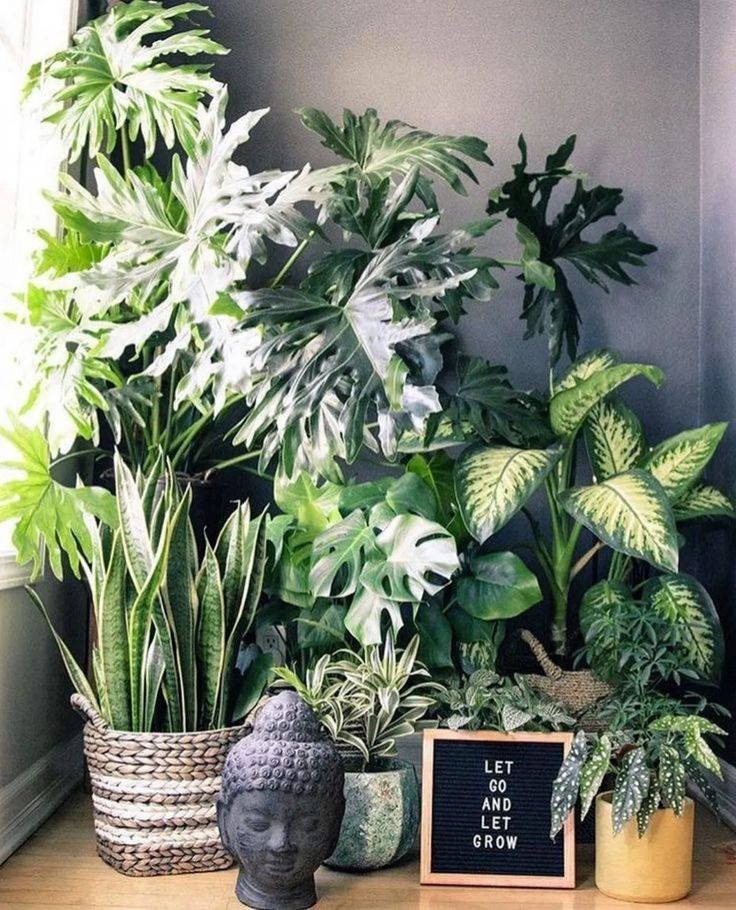 . Floor standing:
. Floor standing:
Stationary. If you are the owner of a spacious house or apartment, then this option is fine for you. There are several options for such flower girls., but the most important and, perhaps, their huge disadvantage is, that they are planned at the stage of the architectural design of the premises. They are divided into:
- Special waterproof containers, located in the recess of the floor, corresponding to the height of their sides.
- Superficial flower girls. In this case, the floor area, reserved for their placement, lined with waterproofing and only after that the sides are erected.
Mobile. it, perhaps, most widespread form of plant placement. They are usually made from ceramics., wood, plastic, light metal. The most convenient are containers on wheels or casters.. Like stationary flower girls, they need waterproofing.
Tabletop. Usually small enough and their function can be taken over by ceramic dishes without glaze of a suitable shape or glass wide, but shallow containers (although there are options using deep decorative glasses).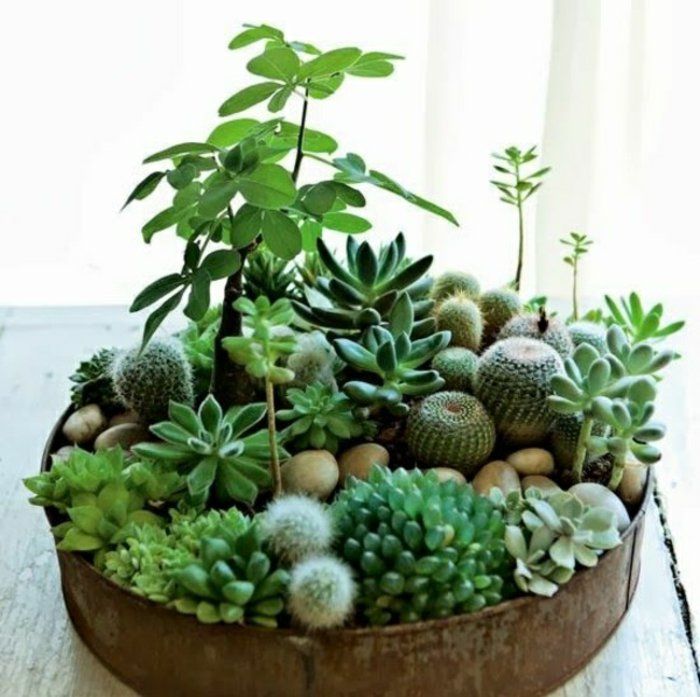 It could also be an old frying pan., it all depends on you.
It could also be an old frying pan., it all depends on you.
Wall mounted (pots). They are lightweight decorative elements from a container for a flower pot and a protective surface of any shape adjacent to the wall, protecting the wall from damage during watering.
Suspended (ampli). Hang on cords of various lengths and are used to decorate window and door openings, arch or niche.
Цветочные композиции из комнатных растений/ Ампельные комнатные цветы/ [Chlorophytum, зебрина, chicken]
Watch this video on YouTube
ACCOMMODATION IN FLOWER
Choosing plants for composition in a flower girl, it is important for yourself to decide, how will you place plants in them – in pots or without. And besides this, it is important to have a sketch of the composition on paper, her appearance and list of plants, which you will use, taking into account their environmental (soil, illumination, humidity, temperature, rest period) features.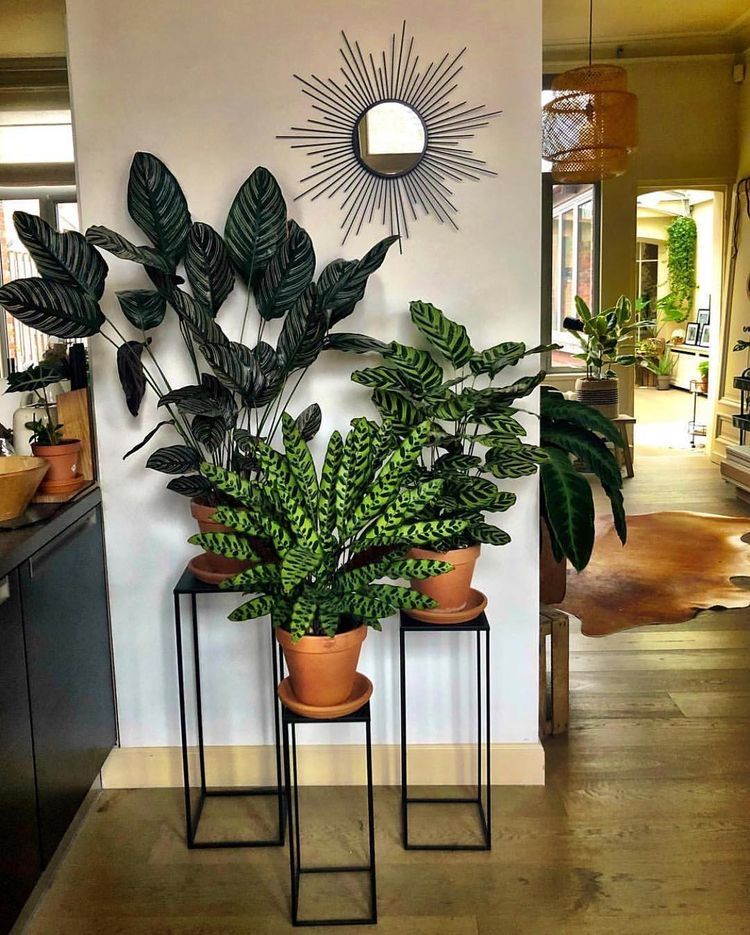
Very convenient to place plants, without taking out of the pots. Due to this, species with different requirements for the water regime can be used in the composition., as each of them can be provided with individual watering.
And it will also allow any plant, if necessary, to be easily obtained and replaced with another.. The spaces between the pots are usually filled with peat or expanded clay., although some gardeners prefer to use the land for these purposes. The substrate surrounding the pots not only gives them additional stability, but also decorative, regulates water exchange, absorbing and retaining water.
Its surface can be decorated with shells, stones, pebbles, driftwood or moss, depending on the theme of the composition. If soil or peat is used as a substrate, then for decorating the surface, you can take ground cover plants, which will create a solid green or variegated background (depending on the color of the foliage) for larger plants compositions.
How to create a home flower arrangement
If the plants, forming the composition, have similar ecological features, as, eg, succulents, then they can be planted without pots in a nutritious substrate, filling container.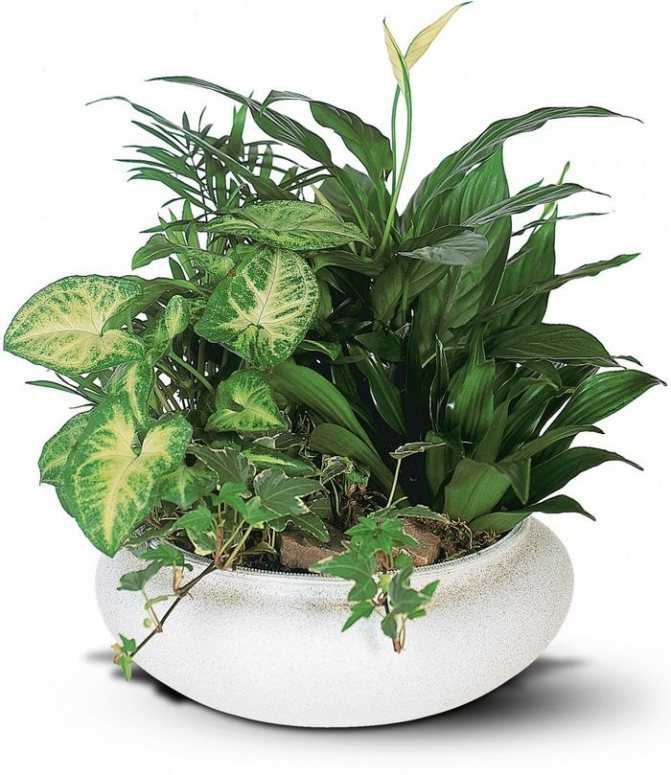 But only in this case, drainage must be placed on the surface of the waterproofing layer (expanded clay, broken brick, small pieces of ceramic pots), which serves to retain water. Plant roots can eventually reach him, but it will only be in a few years, because succulents usually grow slowly.
But only in this case, drainage must be placed on the surface of the waterproofing layer (expanded clay, broken brick, small pieces of ceramic pots), which serves to retain water. Plant roots can eventually reach him, but it will only be in a few years, because succulents usually grow slowly.
When landing in a general container (the most common way of grouping pot) plants retain moisture in soil and air longer, take up less space, complement each other, hiding flaws. Drawing up living decorative compositions should be based on knowledge of the characteristics of each type and the rules of modern arrangement.
The nature and size of plant compositions are varied.: from a tabletop miniature of several small plants to a large volumetric-spatial composition. Compositions can be symmetrical, asymmetric or built on the principle of free, natural arrangement of plants. The number of options is limitless, but when compiling them, the general principles and techniques must always be observed, with which a decorative effect is achieved.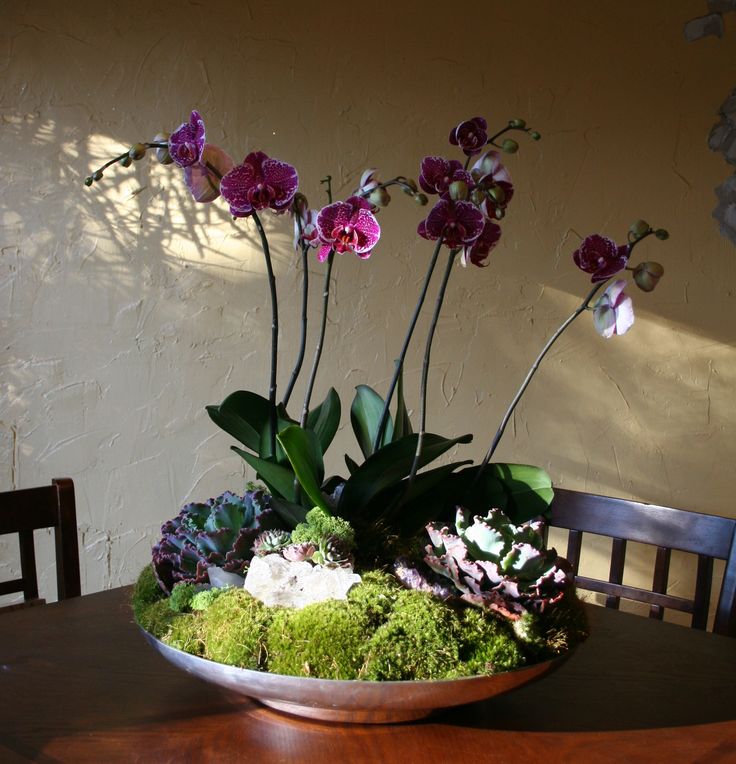 Interior gardening options for living rooms are also inextricably linked with the architectural features of modern buildings.. Each type of interior has its own optimal composition models..
Interior gardening options for living rooms are also inextricably linked with the architectural features of modern buildings.. Each type of interior has its own optimal composition models..
Создание КОМПОЗИЦИЙ из комнатных растений.
Watch this video on YouTube
ELEMENTARY RULES OF FLOWER COMPOSITION
In addition to the relationship to the light, water, temperature and illumination, before, how to get started, it is important to get acquainted with the basic rules for composing a composition.
- Composition proportions, t. is. a certain ratio of its individual parts to each other and to the entire composition as a whole, must obey the laws of harmony. Compositions can be made from plants of the same height or combine species in them, forming several tiers. The multi-tiered composition includes, usually, tall, medium-sized and low-growing plants. Choose a harmonious plant height ratio, included in the composition, can be done using the classical law of the «golden ratio», or «golden ratio», used in architecture and fine arts.
 Its essence is, what’s the relationship between 2 parts of one segment should be the same, as between the whole segment and its greater part (eg, 3:5=5:8, and:в = в (a + b)).
Its essence is, what’s the relationship between 2 parts of one segment should be the same, as between the whole segment and its greater part (eg, 3:5=5:8, and:в = в (a + b)).
Applying this principle, it is easy to determine the correct proportions between high, medium-sized and low-growing plants. By the same principle, the distance between the plants planted in the flower pot is determined..
THE RULE OF GOLDEN SECTION IN FLOWER ARRANGEMENTS
Tall ones can be positioned in the center (to create a symmetrical composition), and in the background or offset to the edge, forming an asymmetrical composition.
You can create single-tiered plantings., for which usually low herbaceous plants of the same species are used, which are used to create one-color borders or compositions of plants with different leaf colors (balsams, wheel mustache, begonias).
- Colour. An important role in creating a composition of indoor (and not only) plants plays a combination of colors and shades, which can be selected according to the principle of harmony or contrast.
 When drawing up a harmonic (nuanced) compositions only use different shades of the same color. Such work requires a wide range of plant species., since the color range from silvery green to dark brown requires a sufficient number of halftones. But a harmonic composition can also be composed of 3-4 species or varieties of plants, similar in color.
When drawing up a harmonic (nuanced) compositions only use different shades of the same color. Such work requires a wide range of plant species., since the color range from silvery green to dark brown requires a sufficient number of halftones. But a harmonic composition can also be composed of 3-4 species or varieties of plants, similar in color.
Contrasting compositions have much more possibilities.. When compiling them, variegated plants can be widely used. (royal begonia, Dieffen-Bahia, koleus, maranta et al.) for creating color spots on the background of plants with a uniform color of leaves. If variegated plants make up the main background of the composition, then the selection of contrasting plants requires special attention. Against the background of variegated plants, plants with large dark green leaves stand out beautifully, but species with small leaves or a bizarre silhouette can be completely «lost» – in any case, they will merge with the main background. For, to get expressive composition, you need to introduce a flowering plant into it, contrasting against the restrained neutral background of decorative deciduous plants. The contrast effect can also be enhanced by combining plants with different textures in the composition. (surface features) stems and leaves.
The contrast effect can also be enhanced by combining plants with different textures in the composition. (surface features) stems and leaves.
The variety of textures of various plant organs gives unlimited possibilities for achieving an artistic effect..
- The form (outlines, general appearance of the plant). This is another expressive means for creating a decorative composition., because the variety of forms of indoor plants allows you to infinitely vary their combinations, achieving all the new decorative effect. But the possibilities of composing are still limited., what is connected with, that plants cannot be combined in them, having serious differences in conditions of detention.
Plants of different shapes, like plants, having different color shades, can be composed according to the contrasting and harmonic principle. So, contrasting in their appearance are the spreading bushes of hogweed begonia with its large pubescent leaves on long thick petioles, and sharp, upright, xiphoid leaves of sansevier, extending from a thick creeping stem, or the dark lace of the butcher’s bush combined with the wide soft leaves of the eucharis.
Do-it-yourself composition of indoor plants
According to the harmonious principle, you can create compositions from different types of begonias., varieties of coleus, tradescantia and setkrezii, ophiopogon and chlorophytum.
- Number of species. Designers usually use no more than 5-7 plant species within one composition. A beautiful and completely finished work can even come from one type. Remember! The decorativeness of the arrangement does not depend on the variety of plants used., but from the ability to choose the right, place and most fully show the beauty of their shapes and color combinations.
- Background. For any composition, it is an important element., on which its decorative effect largely depends. If the background is selected correctly, then it will highlight both the beauty of individual plants, and compositions in general, enhancing its expressiveness. But if the background will live its own separate life, then even the most beautiful composition can be «lost» on it.
 So, for bright contrasting compositions a calm neutral background is required, and plants with large dark green leaves stand out clearly even on fairly variegated mosaic walls. Natural stone surfaces will be a good background for your composition., especially in combination with a pool or aquarium.
So, for bright contrasting compositions a calm neutral background is required, and plants with large dark green leaves stand out clearly even on fairly variegated mosaic walls. Natural stone surfaces will be a good background for your composition., especially in combination with a pool or aquarium.
BEAUTIFUL FLOWER ARRANGEMENTS WITH YOUR OWN HANDS – VIDEO
Красивые цветочные композиции. Для дачи,сада.В горшках. Своими руками. Создаём красивый сад сами.
Watch this video on YouTube
Цветочные композиции Home Decor — Etsy.de
Etsy больше не поддерживает старые версии вашего веб-браузера, чтобы обеспечить безопасность пользовательских данных. Пожалуйста, обновите до последней версии.
Воспользуйтесь всеми преимуществами нашего сайта, включив JavaScript.
Найдите что-нибудь памятное,
присоединяйтесь к сообществу, делающему добро.
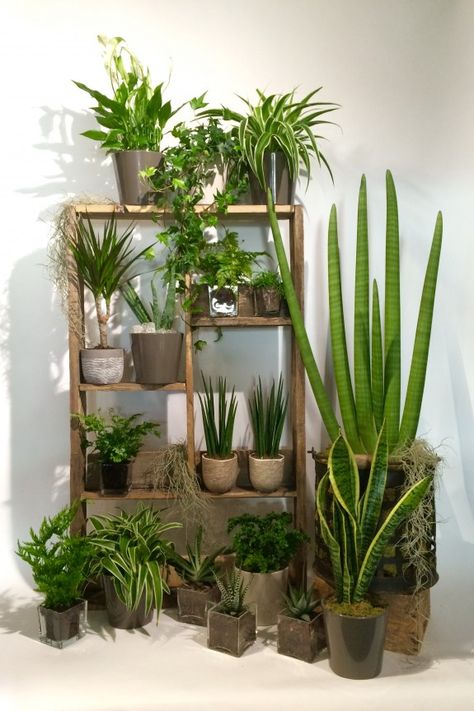
(более 1000 релевантных результатов)
цветочных композиций | Дома
Перейти к основному содержанию
Перейти к содержимому нижнего колонтитула
Функциональность Javascript в вашем браузере отключена.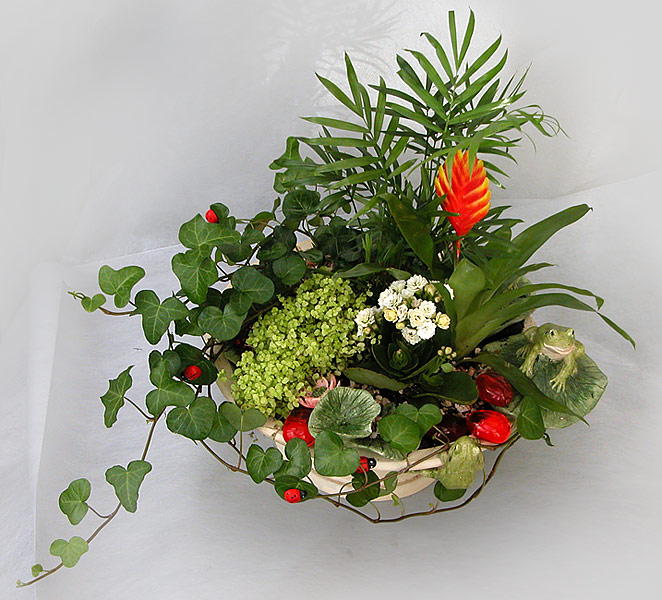 Пожалуйста, включите его, чтобы вы могли испытать все возможности этого сайта.
Пожалуйста, включите его, чтобы вы могли испытать все возможности этого сайта.
Цветочные композиции
Цветочные композиции | Дома
Дом
Декор и подушки
Искусственные цветы и зелень
Цветочные композиции
Почтовый индекс или город, штат
или колледж
300 миль
Неверный формат почтового индекса
Использовать мое текущее местоположение
Самое популярное
Цена: от высокой к низкой
Цена: от низкой до высокой
Лучшие по рейтингу
Что можно найти:
ИНСАЙДЕРЫ НАСЛАЖДАЮТСЯ
ЭКСКЛЮЗИВ
ЭКОНОМИЯ
Магазин Flash Finds на этой неделе
ИНСАЙДЕР
PERKS
ПРИСОЕДИНЯЙТЕСЬ К
СКИДКА 10%
Присоединяйтесь бесплатно
398 шт.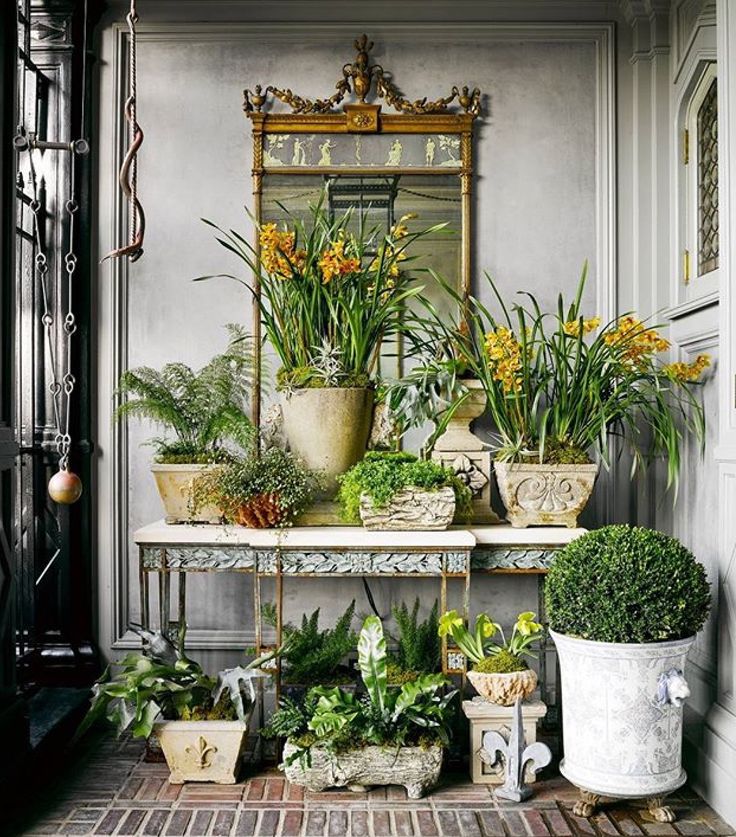
Растение самшита с квадратным черным кашпо, 12 дюймов
$12,99
Посмотреть товар
Быстрый просмотр
Растение самшита с черным кашпо, 8 дюймов
6,99 $
Посмотреть товар
Быстрый просмотр
Цветы гортензии в стеклянной вазе, 6,5 дюйма
9,99 $ —
$9,99
$4,99 —
9,99 $
Посмотреть товар
Быстрый просмотр
Агава с белым керамическим горшком, 6 дюймов
$4,99
Посмотреть товар
Быстрый просмотр
Суккулент в цементном горшке с имитацией мрамора, 4 дюйма
$4,99
Посмотреть товар
Быстрый просмотр
Набор из 3 суккулентов в вазе-коробке, золото
9,99 $
Посмотреть товар
Быстрый просмотр
Цветы гортензии с деревянным кашпо, 16 дюймов
$19,99
Посмотреть товар
Быстрый просмотр
Мини-травяное растение Honeybloom с кашпо, 11 дюймов
5,99 $
Посмотреть товар
Быстрый просмотр
Суккулент с травой в керамическом горшке, 17 дюймов
$39,99
Посмотреть товар
Быстрый просмотр
Травянистое растение с кашпо White Square, 10 дюймов
7,99 $
Посмотреть товар
Быстрый просмотр
Шаровая установка из самшита с черным кашпо, 16 дюймов
29,99 $
Посмотреть товар
Быстрый просмотр
Дерево бонсай с кашпо из черной керамики, 14,5 дюйма
29,99 $
Посмотреть товар
Быстрый просмотр
Забыли пароль?
Имя
Фамилия
Номер телефона
Почтовый индекс
День рождения
Так что мы можем дать вам купон на день рождения!
Адрес электронной почты
Требуется не менее 8 символов.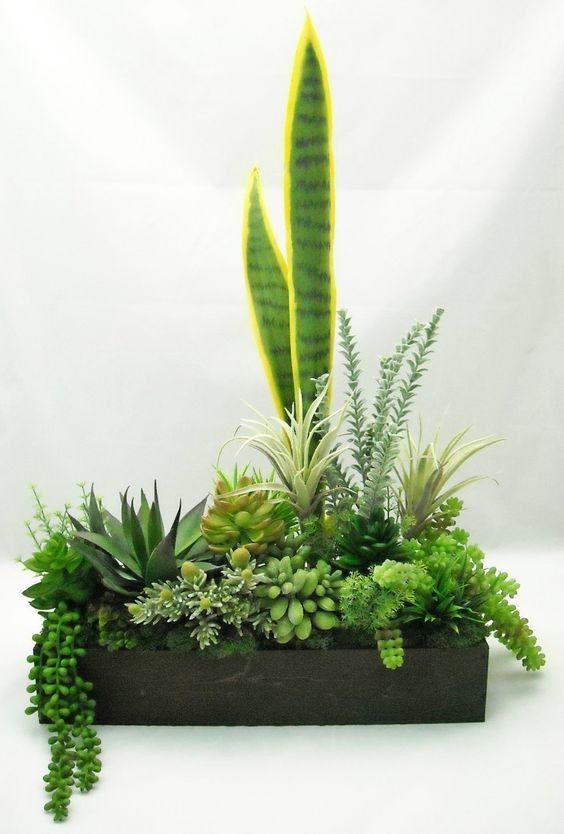

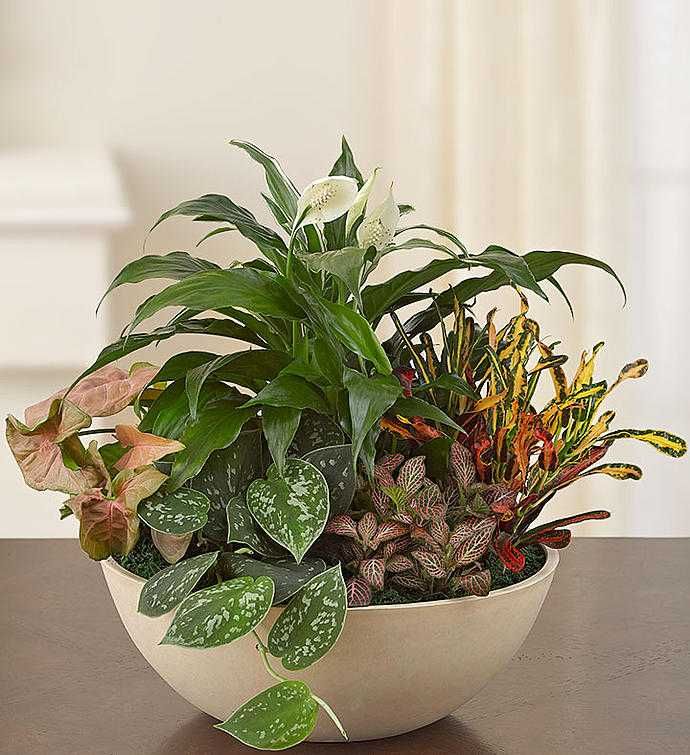 It serves to, so that, one side, create an impression of the integrity of the composition, on the other hand, highlight its individual elements;
It serves to, so that, one side, create an impression of the integrity of the composition, on the other hand, highlight its individual elements;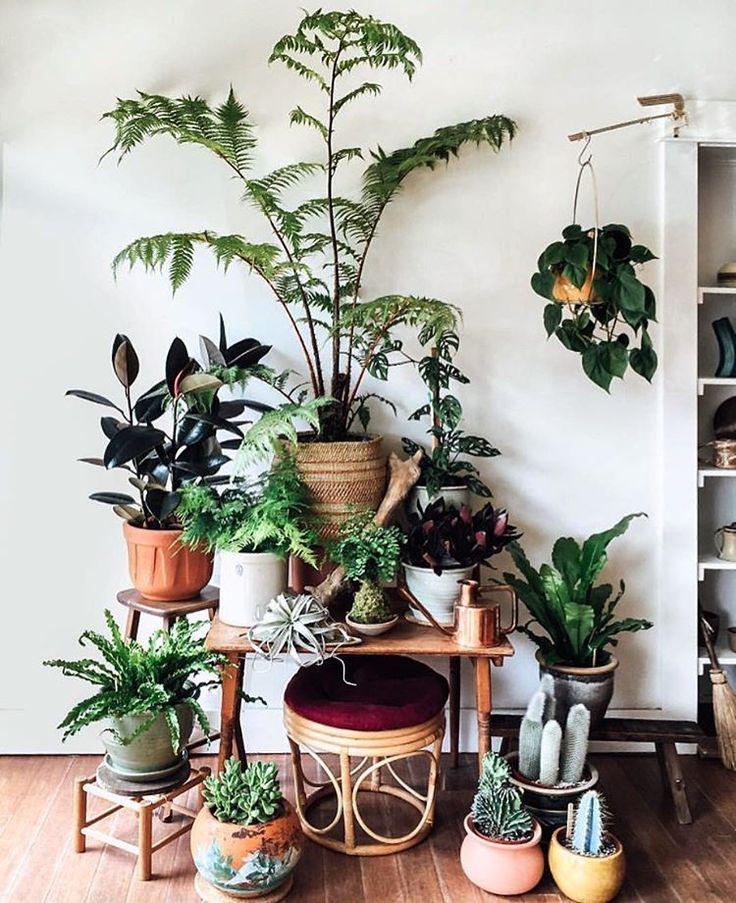 Its essence is, what’s the relationship between 2 parts of one segment should be the same, as between the whole segment and its greater part (eg, 3:5=5:8, and:в = в (a + b)).
Its essence is, what’s the relationship between 2 parts of one segment should be the same, as between the whole segment and its greater part (eg, 3:5=5:8, and:в = в (a + b)).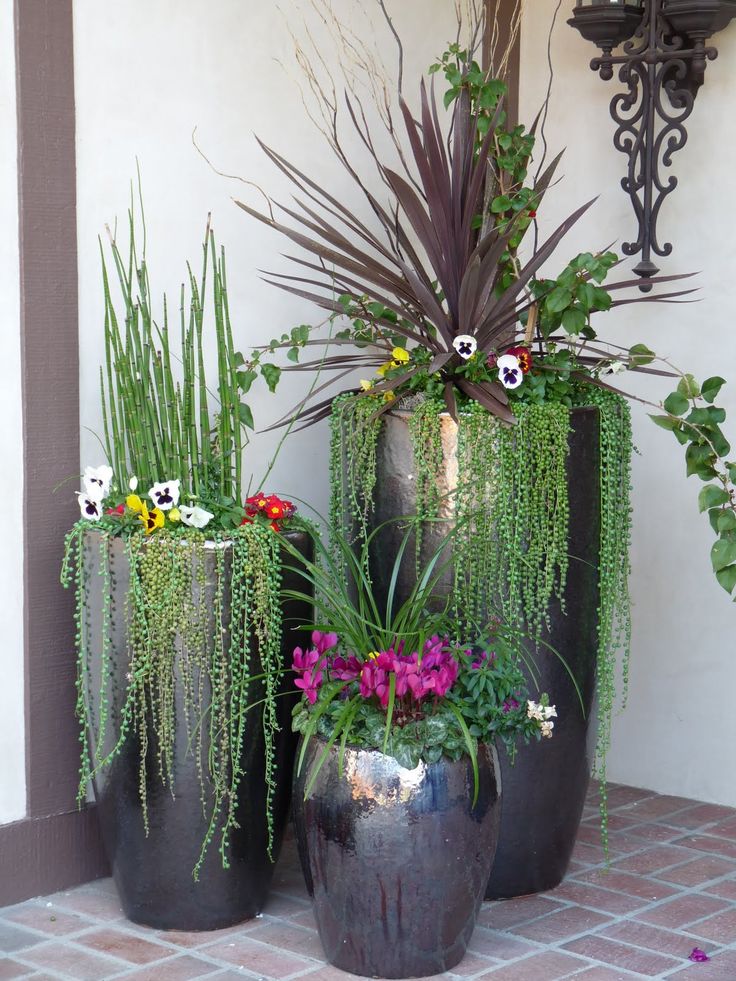 When drawing up a harmonic (nuanced) compositions only use different shades of the same color. Such work requires a wide range of plant species., since the color range from silvery green to dark brown requires a sufficient number of halftones. But a harmonic composition can also be composed of 3-4 species or varieties of plants, similar in color.
When drawing up a harmonic (nuanced) compositions only use different shades of the same color. Such work requires a wide range of plant species., since the color range from silvery green to dark brown requires a sufficient number of halftones. But a harmonic composition can also be composed of 3-4 species or varieties of plants, similar in color.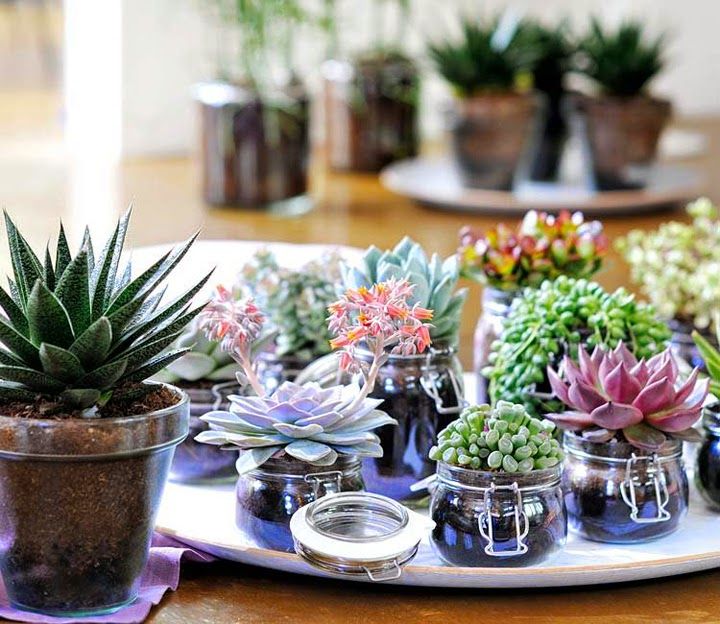 So, for bright contrasting compositions a calm neutral background is required, and plants with large dark green leaves stand out clearly even on fairly variegated mosaic walls. Natural stone surfaces will be a good background for your composition., especially in combination with a pool or aquarium.
So, for bright contrasting compositions a calm neutral background is required, and plants with large dark green leaves stand out clearly even on fairly variegated mosaic walls. Natural stone surfaces will be a good background for your composition., especially in combination with a pool or aquarium.